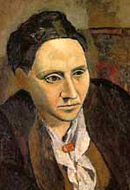Gertrude Stein, Fascist?

Does it say something that the most indelible portraits of Gertrude Stein come from the outside? Or, to frame the question a different way: what does it say when our most lasting impressions of a writer are based not on her words, but on the visions and appropriations of others? Certainly the most enduring image of Stein is the portrait painted by Picasso in 1905–6, now in New York's Metropolitan Museum of Art. Here Picasso's style hangs somewhere between realism and cubism: the body is proportionate and representative, but the face is inhuman, as if Picasso formed it by funneling his memories of the modernist writer through a matrix of African and Iberian sculpture. Nonetheless, the painting has become our collective vision of Stein. As Picasso said, "Everybody thinks she is not at all like her portrait. But never mind, in the end she will manage to look just like it."
Even when Stein appears to open up and speak about herself she does so through the glance of another. Her most famous work, The Autobiography of Alice B. Toklas, is her autobiographical story told in the voice of her lover. It is the literary equivalent of Picasso's portrait: a distorted, blocky image that values aesthetics over representation. The prose is accessible (for Stein, anyway), but it rarely welcomes the reader. Stein gives us names, and details, and events, but only the most oblique references to emotions.
It would be the worst kind of psychological reading to suggest that Stein's prose is evasive and trying to hide something; there were many aesthetic reasons to experiment with narrators and perspective and the idea of "autobiography." But it does expose the distance between the legends of Stein as modernist innovator and the private, complicated individual. We know Stein as painted by Picasso, written by Hemingway, and acted by Kathy Bates. The actual person recedes from view.
This discrepancy between the imaginary Stein and the private Stein is, in a sense, the true subject of Barbara Will's recent Unlikely Collaboration: Gertrude Stein, Bernard Faÿ, and the Vichy Dilemma. Will's book, the latest and most thorough investigation (and this is very much a detective story) of Stein's political ideology, is extremely detailed and erudite, and brings to public attention what had previously been hidden in scholarly journals: Stein's wartime translations of the speeches of Marshal Philippe Pétain, head of France's Vichy regime, with a highly sympathetic introduction that compares Pétain to George Washington.
Will combs Stein's archives for clues about her "collaboration"—what it constituted, whether it was genuine—and comes away convinced that Stein is guilty of "commitment" to Pétain. But, as often as not, the evidence points to a fundamental murkiness. No matter how much the archive appears to answer and expose, questions always remain, and we frequently cannot say what Stein intended. What appears to be unassailable evidence of collaboration can just as easily be unassailable evidence of Stein's survival instinct. Perhaps there is no difference.
Consider the Pétain documents themselves. What can we actually say about them? The book was never published, the translations were shoddy, and there are hints in Wars I Have Seen that she abandoned Pétainism. (Her Pétainism was originally genuine.) But Stein was also a Jewish woman (as was Toklas) whose life depended on the protection of Vichy officials, and there is the very real possibility that Stein's self-styled role as Vichy propagandist was a fiction necessary for survival. Or it is at least an embellishment. Reading this way, we enter a second murkiness of morality, and approach the question of when self-preservation becomes outright collaboration. It is not a comfortable place.
In order to make sense of the Pétain documents, Will scrutinizes almost every shred of Stein's writing, from articles, essays, and novels to private letters and notes, and reads them for what they might say about Stein's actions. As Will writes, "It would be a mistake to simply dissociate Stein's early 'progressive' experimental writing from her later 'reactionary' politics to excuse or compartmentalize. The tendencies that drew Stein toward both Bernard Faÿ and Philippe Pétain, we could say, were always there."
The downside of this detective work, however, is immediately apparent. Will reads Stein's 1920 poem "The Reverie of the Zionist" as a piece of proto-fascism. "Ten years later, this kind of rhetoric would begin to have troubling resonances." But little in the poem is radical, or troubling. Stein writes that Judaism is a religion, and not a race, and that Zionism does not speak for all Jews. In other words, Stein's position is no different from any number of contemporary critiques of Zionism.
My interest here is not in excusing Stein. I have no love for her early work such that I would defend the author at all costs. Whether or not "collaboration" accurately describes what Stein did, her blindness toward Pétain is discomfiting, and serious. There is also Stein's unconscionable 1934 remark to the New York Times Magazine, "I say that Hitler ought to have the peace prize." But I am equally suspicious of Will's desire to read Stein backward, and to hunt for "tendencies" in texts decades removed. Doing so uncomfortably decontextualizes her early writing and finds the sinister in the mundane.
Although I disagree with her methodology, Will deserves credit for directly addressing the central moral question posed by the Pétain documents: How do we continue to read Stein? As unsatisfying as it may be, the only responsible thing a reader can do is to be cognizant and conscious of the evidence when we read her work. Our challenge is to read Stein without excusing or convicting, but with eternal doubt and moral ambiguity. In other words, to never quite dismiss the charges.
Eitan Kensky is a doctoral candidate in Jewish studies at Harvard University, focusing on Jewish American literature and culture.
Comments are closed for this article.




